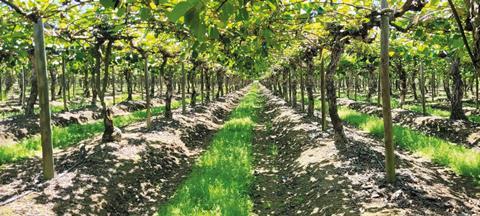Low European stocks augur well for the start of the Chilean kiwifruit campaign but New Zealand volumes are up

Chile is anticipating a kiwifruit export crop of 130,000 tonnes this year, representing an increase of around 3.5 per cent on 2023. Speaking to Fruitnet as growers geared up for the start of the 2024 kiwifruit season, Carlos Cruzat, president of the Chilean Kiwifruit Committee said a low number of cold hours this season has caused a drop in the fertility of the plants, resulting in a greater proportion of category 2 fruit.
“The fruit has grown well, it has an intense green colour, but the season is running a little late.” he said. “At this stage, careful irrigation will help improve dry matter but the start of the season will depend on when the fruit is ready and whether it has accumulated a high enough Brix level.”
From this season, growers will be supported by an app providing up-to-the-minute information on fruit growth and evolution. “That way producers can know what is happening at each orchard and what is being harvested in each region and at national level,” he says.
Regarding the market outlook, Cruzat says lower European stocks indicate that early demand will be high. “This year Europe has a significantly smaller amount of fruit available. Greece and Italy both saw a 30 per cent decrease in production while Portugal, Spain and France also have smaller volumes. The result is that European stock levels are almost 50 per cent lower than last year,” he says.
Offsetting that, the recovery in New Zealand’s production this year will lift the availability of Southern Hemisphere fruit. “New Zealand will produce around 115,000-130,000 tonnes more than last season, which is equivalent to Chile’s entire output. So no matter how clear the markets are, there will be a large volume of fruit hitting the market when we start our season, which must be taken into account,” Cruzat says.
In terms of promotions, the committee’s plans to carry out marketing campaigns in India and the US. “We’ll also be carrying out in-store tastings and social media activities in Brazil and Mexico,” Cruzat says. “Brazil is an important market and has grown significantly in recent years so it’s important that we continue to focus on growing consumption there.”
In the medium term, varietal replacement is one of the biggest challenges facing the sector. Cruzat acknowledges that in the past, the country has had difficulties in developing new varieties.
“At a global level, the trend is that yellow kiwifruit is going to grow significantly. Today, about 50 per cent of exports are yellow fruit, and the remainder green, but in a few years yellow fruit will account for 75 per cent of the total,” he says.
“Therefore, Chile has the challenge of planting more yellow varieties. In the last 20 years we’ve had poor results because of Psa and Verticillium – of some 1,650ha planted, there remain just over 200 productive hectares.”
To counter this, the industry has set up a varietal working group to support the arrival and establishment of new varieties.



